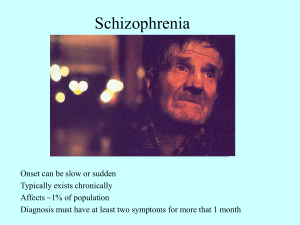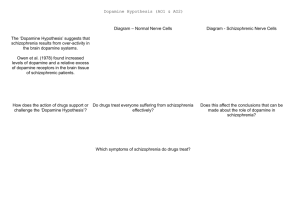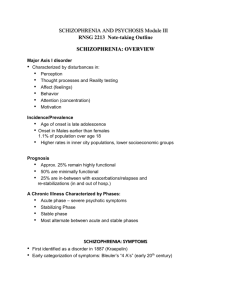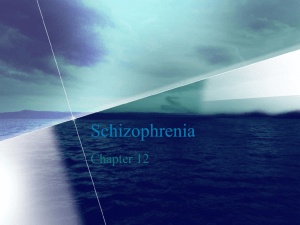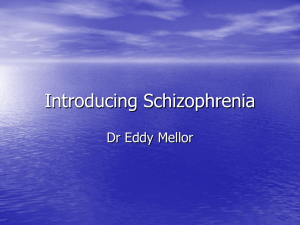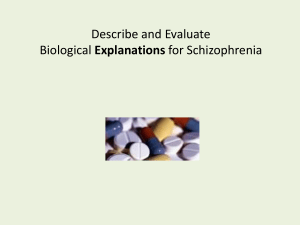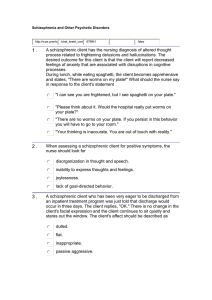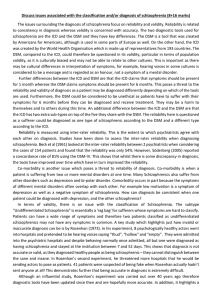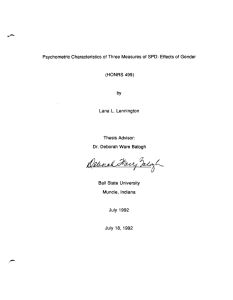Psychotic disorders - Ms. Zolpis' Classes
advertisement
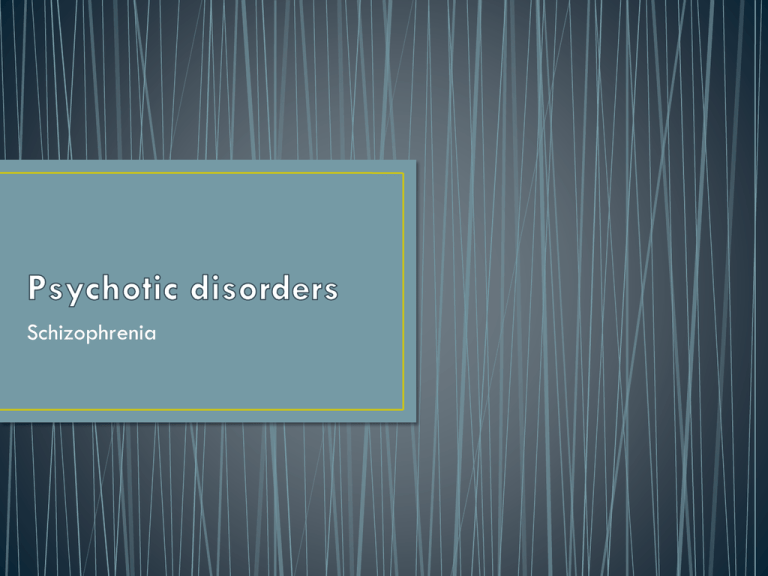
Schizophrenia • A psychosis or psychotic disorder involves a major disorganization of thought processes, confused and extreme emotional responses, and distorted perceptions of the world. • There is a loss of contact with and difficulty in recognizing reality. • Thus, it is a very serious mental disturbance. • Most researchers do not think that it is an extension or outgrowth of less severe disorders but that it is a separate problem that arises all by itself. • All four may not be present in one individual, but typically at least two are. (1) The first symptom is a serious distortion of mental processes. Often it is hard to understand exactly what psychotic people are trying to say or to grasp what they are thinking. This behavior comes and goes so that they are lucid for a while, then very confused. This symptom is called thought disorder. (2) The second symptom involves seeing or hearing things that are not there. Again, this comes and goes. It is not unusual for psychotics to hear voices or see objects that are not present. This behavior is called hallucinating. (3) Next, many psychotics hold grossly inaccurate beliefs, such as thinking of themselves as avenging angels or as victims of persecution by some secret organization. Such a belief is called a delusion. (4) Finally, psychotics have a great deal of trouble with emotional responses. The emotions shown are quite inappropriate; they might show no response at all when something interesting happens, for example, or they might laugh at a tragic event. We seriously doubt that they really think it is funny; instead, we think that they are quite confused and dominated by a malfunctioning brain. • Schizophrenia = most serious of all mental disturbances. • It affects about 1% of the population. • Obvious symptoms of this problem are disorganized thoughts and garbled speech, as well as hallucinations and delusions. • Researchers doubt that schizophrenia is a single disorder but instead feel that there are different causes and degrees of severity. • For example, about a third of such patients have one episode and get better, never to have it happen again; a third have very severe symptoms and do not respond to very much treatment at all; the final third are in and out of institutions most of their lives. • We suspect that schizophrenia results mostly from some physical or chemical problem because it appears in late adolescence or early adulthood, almost never earlier. • This fact would tend to rule out the suggestion that it is mostly psychological, because psychological cases should result in the problem appearing at almost any age. • In some cases, schizophrenics will speak what is called word salad. Like the ingredients of a tossed salad, the words are all mixed together. • “The house burnt the cow horrendously always.” • Or there are what are called clang associations, which refer to the fact that the speech has a rhythm like a bell: “You wear clothes and how much does this watch cost? Have you a sister? I have three and they are all fine girls, curls, furls, isn’t that funny?” The clang comes out with “girls, curls, furls.” • All schizophrenia has certain symptoms in common, especially thought disorders. However, there are several subtypes, three of which are described here. 1. Catatonic – The hallmark of catatonic schizophrenia is a disturbance of movement. Catatonics usually do not speak, or they say very little. They appear to be in a stupor much of the time. They may rigidly hold a peculiar posture or simply stand or sit, unmoving, for hours. 2. Paranoid – Paranoid schizophrenia is marked by strong feelings of persecution and suspiciousness. It often includes grandiose beliefs as well. For instance, a paranoid schizophrenic might believe that he or she has some kind of special or superhuman power. 3. Undifferentiated – Undifferentiated schizophrenia is just what the term implies. That is, there is nothing special to differentiate or distinguish it. Many professionals consider this a catchall category. In other words, this category is used when a schizophrenic does not fit into any other subtype. • Schizophrenics are not necessarily out of touch with reality all the time. Their unusual behavior (called psychotic episodes) often comes in cycles, and in between the person is reasonably lucid. • But often even those who seem unaware of their surroundings are not really as completely lost as they may appear. • Example: One story about this involves a loud and obnoxious student nurse who frequently made unflattering remarks about the patients. One day she leaned over to make a bed next to the one on which a catatonic schizophrenic patient had been sitting immobile for many hours. She commented on how stupid she thought this behavior was and suddenly received a good solid kick in the rear. By the time she had whirled around, the patient had “resumed his ‘poker face’ expression and former posture.” • Think back to the last time you were at a party with some good friends and everyone was sitting in a circle. When the discussion really got going, people were talking rapidly and were agitated; thoughts were moving very fast. When that was happening, the level of one of the chemicals that fires nerve cells in the brain was quite high, causing a speed of speech and thought that eventually would exhaust most people. This chemical is called dopamine. • A major discovery about many schizophrenics is that they have normally high levels of dopamine in the brain. • This certainly can explain many of their thought problems. • If thoughts are running through their heads at a maximum speed hour after hour, day after day, this would cause confusion and eventually stupor from fatigue - which is just the way many schizophrenics act. • Studies with animals show that drugs that increase the levels of dopamine far beyond normal produce bizarre behavior in the form of strange posturing and robot-like movements-again symptoms often seen in schizophrenics. • Finally, some schizophrenics get much better when they are given drugs that reduce dopamine levels. The only problem is that these same drugs can cause all kinds of side effects in some patients, including uncontrollable tremors. • Of importance here, though, is that scientists are on the right track. But they have not been able to refine the medication enough so that it works safely for most patients. • We should add that some researchers feel that psychological problems can also cause the body to manufacture too much dopamine, so we are not limited only to a physical problem that can be cured by merely chemical means. • Still, we are on our way toward solving one of life’s most destructive disturbances. • Two additional points: (1) The rapidity of thought with the schizophrenic does not ever resemble that of the manic discussed earlier. Schizophrenics speak an act as if they are exhausted from too much thought, (2) The chemical defect in mood disorders does not involve dopamine. That chemical, as mentioned, is serotonin. There is some very subtle difference in the chemicals that we don’t completely understand yet. • http://www.youtube.com/watch?v=LWYwckFrksg • http://www.motherjones.com/mojo/2013/11/what-welearned-sandy-hook-crime-report • http://www.psychologytoday.com/blog/keeping-kidssafe/201212/the-massacre-sandy-hook-elementary-school “You want to know why. This may sound cynical, but here's why. It's because of the way the media reports it. Flip on the news and watch how we treat the Batman theater shooter and the Oregon mall shooter like celebrities. Dylan Klebold and Eric Harris are household names, but do you know the name of a single 'victim' of Columbine? Disturbed people who would otherwise just off themselves in their basements see the news and want to top it by doing something worse, and going out in a memorable way. Why a grade school? Why children? Because he'll be remembered as a horrible monster, instead of a sad nobody. CNN's article says that if the body count "holds up", this will rank as the second deadliest shooting behind Virginia Tech, as if statistics somehow make one shooting worse than another. Then they post a video interview of third-graders for all the details of what they saw and heard while the shootings were happening. Fox News has plastered the killer's face on all their reports for hours. Any articles or news stories yet that focus on the victims and ignore the killer's identity? None that I've seen yet because they don't sell. So congratulations, sensationalist media, you've just lit the fire for someone to top this and knock off a day care center or a maternity ward next. You can help by forgetting you ever read this man's name, and remembering the name of at least one victim. You can help by donating to mental health research instead of pointing to gun control as the problem. You can help by turning off the news." • “I Am Adam Lanza’s Mother” article


